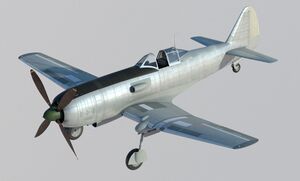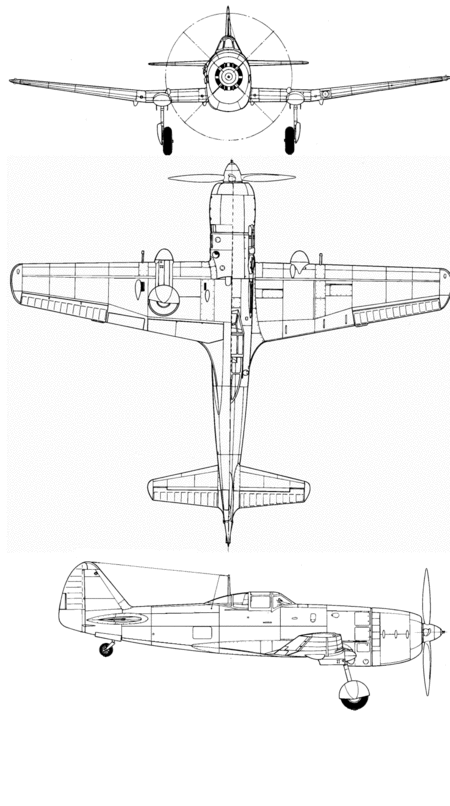Akula TP-87
| Akula TP-87 | |
|---|---|

| |
| Role | Fighter Night fighter |
| National origin | Tennai |
| Manufacturer | Akula Aircraft Company |
| First flight | February 1936 |
| Introduction | August 1936 |
| Retired | 1948 |
| Status | Retired |
| Primary user | Royal Tennaiite Air Force |
| Produced | 1936-1945 |
| Number built | 20,722 |
The Akula TP-87 was a Tennaiite high-altitude fighter of the Siduri War. It was a single seat, exhaust-driven turbo-supercharged engined, low-wing monoplane with a convential undercarriage. It generally considered one of the best fighters to serve during the conflict. The aircraft boasted high speeds and excellent maneuverability with and an armament (four 20 mm or two 30 mm and two 20 mm cannons) that gave it formidable firepower. The TP-87s performance gave it a distinct edge over a majority of Inner Sphere aircraft. Its high operational ceiling enabled it to intercept high-flying aircraft and fight effectively in the high altitudes necessary to navigate the Northern and Southern Khastravali Mountains. The TP-87 saw service among various Common Axis air forces and was the aircraft of at least two different aces.
Development
In 1934, it was recognized that with the rapid advances in aircraft design and the seemingly inevitable conflict with the Inner Sphere, that a new single engine fighter was needed to supplement the Cp 117 and the in-development Cp 120.
Unlike the two Cheppali aircraft, the new fighter was to use a air-cooled radial engine fitted with a supercharger for high-altitude operations over the Khastravali Mountains. The choice of a radial engine was made for the much higher power output provided by radial engines of the time and also the higher maximum power potential in advanced versions of an engine. Initially the TP-87 was to be fitted with Akula's own 14-cylinder Curavali AC143 intended to upgrade the TK-22 medium bomber as development of Curavali's successor, the 18-cylinder AC222, was still ongoing and would likely not be ready for a another couple of years. When the first protype flew with the AC143, its performance was described as "sluggish".
Following several design refinements and the fitting of an AC222 engine, the TP-87 proved to be very fast and highly maneuverable. It also displayed superb high-altitude performance and an excellent rate of climb. In February of 1936, the TP-87 was accepted by the RTAF and was ordered into production. The first units equipped with TP-87s began flying missions in August of the same year.
Design
The TP-87 was a cantilever low-wing monoplane of all-metal construction with conventional landing gear. Armament comprised two four 20 mm cannons or two 20 mm and two 30 mm cannons mounted in the wings. These provided considerably more firepower than what was availabe in the early variants of the Cheppali 117 and 120. The TP-87 could also carry two 250 kg (550 lb) bombs and two 200 l (53 gal) drop tanks for extended range. The TP-87 used a 65 mm (2.56 in) armor-glass canopy, 13 mm (.51 in) of head and back armor, and multiple bulkheads in the fuselage, which protected both the methanol-water tank (used to increase the effectiveness of the turbo-supercharger) and the centrally located fuel tank.
It was the Akula firm's own-designed AC222 air-cooled eighteen-cylinder radial engine, first accepted for military use in 1936, that gave the TP-87 its high speed and prowess in combat. In order to maintain its high-performance attributes at high-altitudes, the TP-87's AC222 engine was fitted with a turbo-supercharger. Derived from the Akula Curavali engines common to many Tennaiite radial-engine aircraft, the TP-87 used the AC222 direct-injection version of the engine, using water injection to aid the turbo-supercharger in giving the TP-87 a rated 1,800kW (2,400 hp) at takeoff. Later variants would use the more powerful AC222-IIA engine rated at 2,237kw (3,000 hp).
A unique feature, and one included in later designs such as the Mahindra V7K, was a mercury switch that automatically extended the flaps during turns. These "combat" flaps created more lift, thereby allowing tighter turns. This freed up the pilot's concentration and reduced the chance of stalling in combat. The TP-87 had a rearward folding undercarriage to accommodate the storage of ammunition for the cannons, which were mounted in the wing.
Operational history
Siduri War
Variants
- TP-87-IIA
- Initial production model equipped with 2,400 hp Akula AC222 engine and 4 x 20 mm cannons in the wings.
- TP-87-IIB
- Production model equipped with 2 x 20 mm cannons and 2x 30 mm cannons in the wings.
- TP-87-IIC
- Night fighter variant. Armed as the Tp-87-IIA
- TP-87-IIIA/B
- Same engine and armament as the TP-87-IIA/B. Cabin pressurization added for improved high-altitude performance.
- TP-87-IIIC
- Night fighter variant of TP-87-IIIA/B
- TP-87-IVA
- Equipped with a 3,000 hp AC243 engine and armed as the TP-87IIA. Bomb load increased and hardpoints for the carrying of rockets made available.
- TP-87-IVC
- Night fighter variant of TP-87-IVA
Operators
Specifications (TP-87-IIA)
General characteristics
- Crew: 1
- Length: 11.82 m (38 ft 9 in)
- Wingspan: 13.423 m (44 ft 0 in)
- Height: 4.503 m (14 ft 9 in)
- Wing area: 26 m2 (280 sq ft)
- Empty weight: 4,387 kg (9,672 lb)
- Gross weight: 5,632 kg (12,416 lb)
- Max takeoff weight: 6,100 kg (13,448 lb)
- Powerplant: 1 × Akula AC222 18-cylinder air-cooled radial piston engine, 1,800 kW (2,400 hp)
- Propellers: 4-bladed constant-speed propellers
Performance
- Maximum speed: 706 km/h (439 mph; 381 kn) at 11,000 m (36,089 ft)
- Cruise speed: 482 km/h (300 mph; 260 kn)
- Range: 2,168 km (1,347 mi; 1,171 nmi)
- Combat range: 1,300 km (808 mi; 702 nmi)
- Service ceiling: 12,855 m (42,175 ft)
- Time to altitude: 10,000 m (32,808 ft) in 10 minutes
- Wing loading: 216.6 kg/m2 (44.4 lb/sq ft)
- Power/mass: 0.3161 kW/kg (0.1923 hp/lb)
Armament
- Guns:
- 4 × 20 mm (0.787 in) Basu FG 20-35 cannons in wings, 200 rounds/gun
- or
- 2 x 20 mm (0.787 in) Basu FG 20-35 cannons in wings, 200 rounds/gun and 2 x 30 mm (1.181 in) TN 150 cannons in wings, 70 rounds/gun
- 2 × 250 kg (550 lb) bombs
- 2× 200 l (53 US gal) drop tanks
Avionics
Kol 102-G2 radio
